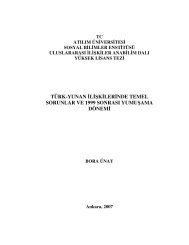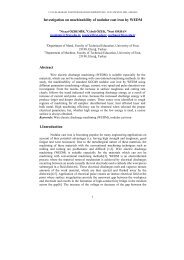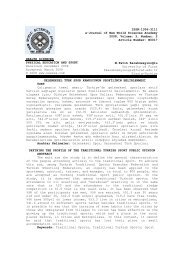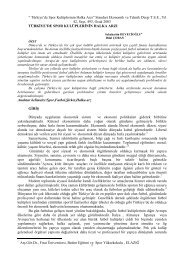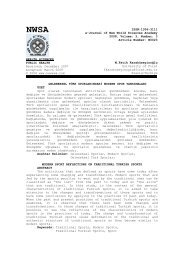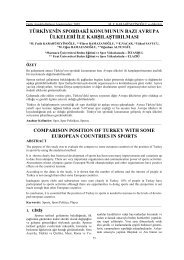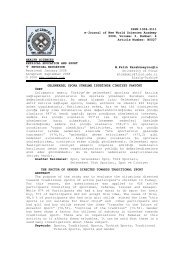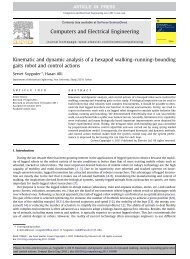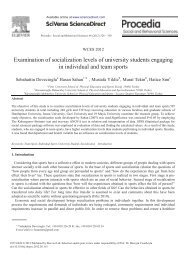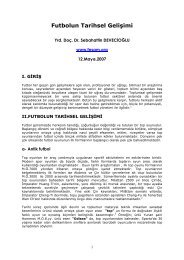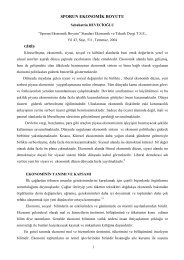WinClastour—a Visual Basic program for tourmaline formula ...
WinClastour—a Visual Basic program for tourmaline formula ...
WinClastour—a Visual Basic program for tourmaline formula ...
Create successful ePaper yourself
Turn your PDF publications into a flip-book with our unique Google optimized e-Paper software.
Computers & Geosciences 32 (2006) 1156–1168<br />
<strong>WinClastour—a</strong> <strong>Visual</strong> <strong>Basic</strong> <strong>program</strong> <strong>for</strong> <strong>tourmaline</strong> <strong>for</strong>mula<br />
calculation and classification $<br />
Abstract<br />
Fuat Yavuz a, , Vural Yavuz a , Ahmet Sasmaz b<br />
a I˙stanbul Teknik Üniversitesi, Maden Fakültesi, Jeoloji Mühendislig˘i Bölümü, 34469, Maslak, I˙stanbul, Turkey<br />
b Fırat Üniversitesi, Mühendislik Fakültesi, Jeoloji Mühendislig˘i Bölümü, 23119, Elazıg˘, Turkey<br />
Received 20 July 2005; received in revised <strong>for</strong>m 26 October 2005; accepted 26 October 2005<br />
WinClastour is a Microsoft s <strong>Visual</strong> <strong>Basic</strong> 6.0 <strong>program</strong> that enables the user to enter and calculate structural <strong>for</strong>mulae of<br />
<strong>tourmaline</strong> analyses obtained both by the electron-microprobe or wet-chemical analyses. It is developed to predict cation<br />
site-allocations at the different structural positions, as well as to estimate mole percent of the end-members of the calcic-,<br />
alkali-, and X-site vacant group <strong>tourmaline</strong>s. Using the different normalization schemes, such as 24.5 oxygens, 31 anions,<br />
15 cations (T+Z+Y), and 6 silicons, the present <strong>program</strong> classifies <strong>tourmaline</strong> data based on the classification scheme<br />
proposed by Hawthorne and Henry [1999. Classification of the minerals of the <strong>tourmaline</strong> group. European Journal of<br />
Mineralogy 11, 201–215]. The present <strong>program</strong> also enables the user Al–Mg disorder between Y and Z sites. WinClastour<br />
stores all the calculated results in a comma-delimited ASCII file <strong>for</strong>mat. Hence, output of the <strong>program</strong> can be displayed<br />
and processed by any other software <strong>for</strong> general data manipulation and graphing purposes. The compiled <strong>program</strong> code<br />
together with a test data file and related graphic files, which are designed to produce a high-quality printout from the<br />
Grapher <strong>program</strong> of Golden Software, is approximately 3 Mb as a self-extracting setup file.<br />
r 2005 Elsevier Ltd. All rights reserved.<br />
Keywords: Tourmaline; Electron-microprobe; Wet-chemical; Normalization; Classification; Al–Mg disorder<br />
1. Introduction<br />
Tourmaline is the most important and common<br />
accessory borosilicate mineral in granitic rocks and<br />
their pegmatites, associated metallic hydrothermal<br />
deposits, and metamorphic and sedimentary rocks.<br />
The common occurrence and large stability of<br />
$<br />
Code available from server at http://www.iamg.org/CGEditor/index.htm.<br />
Corresponding author. P.K. 90, 34711, Kadıko¨y, I˙stanbul,<br />
Turkey.<br />
E-mail address: yavuz@itu.edu.tr (F. Yavuz).<br />
ARTICLE IN PRESS<br />
0098-3004/$ - see front matter r 2005 Elsevier Ltd. All rights reserved.<br />
doi:10.1016/j.cageo.2005.10.021<br />
www.elsevier.com/locate/cageo<br />
<strong>tourmaline</strong> in different geological environments<br />
made it important to understand the physical and<br />
chemical conditions of rock <strong>for</strong>mation, as well as<br />
the ore-<strong>for</strong>ming processes and hydrothermal ore<br />
deposits. Occurrence of <strong>tourmaline</strong> in earth crust is<br />
generally controlled by the amount of boron in the<br />
system, the pressure and temperature conditions,<br />
and the composition of circulating fluids. The<br />
general <strong>for</strong>mula of <strong>tourmaline</strong> can be expressed as<br />
XY3Z6T6O18(BO3)V3W, where the major and minor<br />
substitutions exist in the X (Ca, Na, K, vacancy), Y<br />
(Li, Mg, Fe 2+ ,Mn 2+ , Al, Cr 3+ ,V 3+ ,Fe 3+ ,Ti 4+ ),<br />
Z (Mg, Al, Fe 3+ ,V 3+ ,Cr 3+ ), T (Si, Al, B), V (OH,
O), and W (OH, O, F) sites. Currently valid<br />
<strong>tourmaline</strong> species include 13 end-member compositions<br />
(dravite, schorl, chromdravite, povondraite,<br />
buergerite, elbaite, olenite, magnesiofoititte, foitite,<br />
rossmanite, uvite, feruvite, and liddicoatite).<br />
Hawthorne (1999) discussed the possible <strong>tourmaline</strong><br />
minerals taking into account the bond-valence<br />
constraints on the chemical composition of <strong>tourmaline</strong>.<br />
Recent studies on <strong>tourmaline</strong> have shown that<br />
this chemically complex borosilicate can be used to<br />
illuminate the petrogenesis of magmatic and metamorphic<br />
rocks (Henry and Guidotti, 1985; Henry<br />
and Dutrow, 1996; Fuchs et al., 1998).<br />
The International Mineralogical Association<br />
(IMA) has not currently approved a classification<br />
scheme <strong>for</strong> <strong>tourmaline</strong> group minerals as in the case<br />
of amphibole group minerals (Leake, 1978; Leake<br />
et al., 1997, 2004). However, Hawthorne and Henry<br />
(1999) proposed a classification scheme <strong>for</strong> the<br />
<strong>tourmaline</strong> group minerals based on the chemical<br />
composition and ordering at the different sites of the<br />
<strong>tourmaline</strong> structure. Consequently, limited computer<br />
<strong>program</strong>s written in Microsoft s Quick<strong>Basic</strong><br />
(Yavuz 1997; Yavuz et al., 2002) appeared in<br />
literature to calculate and classify the <strong>tourmaline</strong><br />
group minerals. However, Tindle et al. (2002)<br />
referenced <strong>tourmaline</strong> calculation <strong>program</strong> under<br />
Microsoft s Excel based on 31 anions. In this paper,<br />
the original <strong>program</strong> of Clastour (Yavuz et al., 2002)<br />
was re-written as WinClastour in Windows operating<br />
system to get a better graphical user interface and<br />
interaction as the <strong>Visual</strong> <strong>Basic</strong> <strong>program</strong>ming environment<br />
contains <strong>program</strong>ming tools to develop userfriendly<br />
software. WinClastour permits the user to<br />
calculate his or her own electron-microprobe or wetchemical<br />
<strong>tourmaline</strong> data <strong>for</strong> different normalization<br />
procedures such as 31 anion, 24.5 oxygens, 15 cations<br />
(T+Z+Y), and 6 silicons.<br />
2. Program description<br />
2.1. Data entry<br />
Following the installation process, the start-up<br />
view of main <strong>program</strong> appears on the screen<br />
(Fig. 1). Alternatively, upon successful installation,<br />
once the user clicks the WinClastour icon, which is<br />
the executable <strong>for</strong>m of the main <strong>program</strong>, this initial<br />
<strong>program</strong> segment is also displayed. At this part of<br />
the <strong>program</strong>, the new <strong>tourmaline</strong> chemical data can<br />
be entered by clicking the New icon on the tool bar<br />
or by selecting the File ) New File (Ctrl+N)<br />
ARTICLE IN PRESS<br />
F. Yavuz et al. / Computers & Geosciences 32 (2006) 1156–1168 1157<br />
options from the pull-down menu of File. The 24<br />
variables are defined by the <strong>program</strong> <strong>for</strong> <strong>tourmaline</strong><br />
data entry in the following order:<br />
Sample No, SiO2, TiO2, Al2O3, V2O3, Cr2O3, Fe2O3, FeO, MnO, NiO, CoO, ZnO, MgO, CaO,<br />
BaO, Na2O, K2O, Rb2O, Cs2O, Li2O, F, Cl, H2O,<br />
B2O3.<br />
Microprobe or wet-chemical <strong>tourmaline</strong> analyses,<br />
which are entered or saved as ASCII <strong>for</strong>mat in<br />
different spreadsheet <strong>program</strong>, such as Excel TM<br />
, can<br />
be directly imported into to the WinClastour’s data<br />
entry section by using the Copy–Paste options. In<br />
this case, the user must enter his or her own<br />
<strong>tourmaline</strong> data as in the order cited above to<br />
obtain the correct output from the clipboard.<br />
Additional knowledge on data entry or similar<br />
topics can be accessed by pressing the F1 function<br />
key. This key is used to display the Winclastour.hlp<br />
file on screen. For example, by selecting the Data<br />
Entry section from the Index of Winclastour.hlp file<br />
and clicking the Display button during the help file<br />
is activated, it opens the necessary documents about<br />
the <strong>tourmaline</strong> Data Entry on screen.<br />
2.2. Program details<br />
Once the data entry is completed and saved under<br />
a user-defined file name, the <strong>program</strong> output is<br />
provided by clicking the Calculate icon on the tool<br />
bar or selecting Calculate ) Open File to Calculate<br />
(Ctrl+F) options (Figs. 2A and B). Converting<br />
from wt% oxide values to atomic proportions (apfu)<br />
used in mineral <strong>for</strong>mula estimation is customarily<br />
carried out by normalizing on the basis of the<br />
number of oxygens or anions. WinClastour calculates<br />
the structural <strong>for</strong>mulae of <strong>tourmaline</strong> on the<br />
basis of 24.5 atoms of oxygen as a default. Nevertheless,<br />
the <strong>program</strong> allows the user to select the<br />
normalization parameter <strong>for</strong> the calculation of<br />
structural <strong>for</strong>mulae on the basis of 31 anions,<br />
T+Z+Y ¼ 15 oxygens, and 6 silicons. During the<br />
<strong>program</strong> run, selected normalization scheme from<br />
Normalization ) Structural <strong>for</strong>mulae of pull-down<br />
menu is displayed at the second base panel (see Figs.<br />
2A and B). In the case of <strong>tourmaline</strong>, 31 anions<br />
normalization seems to be the best-case scenario <strong>for</strong><br />
samples, which have been fully analyzed <strong>for</strong> H2O,<br />
B2O3, and Li2O. While the electron-microprobe<br />
study of rock-<strong>for</strong>ming minerals is valid <strong>for</strong> many<br />
major and minor elements, the ability to analyze H,<br />
B and Li is beyond its capabilities yet. For that<br />
reason, electron-microprobe analysis of <strong>tourmaline</strong>
1158<br />
should be supplemented by light element data either<br />
from different analytical techniques or calculations<br />
based on <strong>tourmaline</strong> stoichiometry.<br />
Tourmalines from Li-pegmatites may contain<br />
significant amount of lithium at Y site. In these<br />
situations, Li content of <strong>tourmaline</strong> can be calculated<br />
stoichiometrically by initially normalizing to<br />
29 oxygens basis (with B calculation) or 24.5<br />
oxygens basis (without B calculation), and then<br />
estimating Li by the expression: Li ¼ 3-(S Y site)<br />
(Henry and Dutrow, 1996). By selecting the<br />
Estimate Li from 3-(Total Y) and checking Yes<br />
option in the pull-down menu of Li Estimation the<br />
present <strong>program</strong> calculates the stoichiometric<br />
amounts of Li2O except <strong>for</strong> 15 cations (T+Z+Y)<br />
option. The allocation of ions to T, Z, Y, and X sites<br />
is sequentially carried out by WinClastour as<br />
follows:<br />
(1) Sum T to 6 using Si, then B (if B43), then Al.<br />
ARTICLE IN PRESS<br />
F. Yavuz et al. / Computers & Geosciences 32 (2006) 1156–1168<br />
Fig. 1. Start-up window <strong>for</strong> WinClastour <strong>program</strong>. User can enter or edit his or her own <strong>tourmaline</strong> data, select normalization procedure<br />
and Li estimation option, and display all calculated output in different window <strong>for</strong>ms.<br />
(2) Sum Z to 6 using excess Al from (1) and then<br />
successively, Mg, V 3+ ,Cr 3+ ,Fe 3+ .<br />
(3) Sum Y to 3 using excess Al from (2), then Ti,<br />
then successively V 3+ ,Cr 3+ ,Fe 3+ , Mg from (2)<br />
and then Mn 2+ ,Fe 2+ , Zn, Ni, Co and Li.<br />
(4) Sum X to 1 using Ca, then Ba, Na, K, Rb, and<br />
Cs.<br />
The Al–Mg disorder between the Y and Z sites<br />
require measured unit cell volume and Mg/<br />
(Mg+Al) ratio in the Z site (Henry and Dutrow,<br />
1996). However, Grice and Ercit (1993) proposed<br />
that in the absence of a cell volume measurement,<br />
Mg in the Y and Z sites can be estimated <strong>for</strong><br />
<strong>tourmaline</strong>s with more than 7 wt% FeO by the<br />
following expressions:<br />
Y Mg ¼ 3½1 Fe=ðFe þ MgÞŠ (1)<br />
Z Mg ¼ðS MgÞ Y Mg (2)
ARTICLE IN PRESS<br />
F. Yavuz et al. / Computers & Geosciences 32 (2006) 1156–1168 1159<br />
Fig. 2. (A) Screen output with recalculation, site-allocation, and classification of <strong>tourmaline</strong> chemical data. (B) Window displaying endmember<br />
fractions of calculated data and selected element ratios <strong>for</strong> <strong>tourmaline</strong> data.
1160<br />
ARTICLE IN PRESS<br />
F. Yavuz et al. / Computers & Geosciences 32 (2006) 1156–1168<br />
Fig. 3. (A) Screenshot of sending all calculated result to Excel spreadsheet by selecting ‘‘View All’’ option in pull-down menu of ‘‘View<br />
Output’’. (B) Typical screen output of ‘‘Output.xls’’ file under Microsoft s Excel spreadsheet by clicking ‘‘Display excel file’’ icon in Excel<br />
window.
Despite the practical approach, these types of<br />
expressions may overestimate Mg especially in the Y<br />
site. Ordering of Mg between the Z and Y sites can<br />
be assigned from different solutions. By selecting<br />
one of these options from Al– Mg Disorder menu,<br />
WinClastour allocates Mg contents of <strong>tourmaline</strong> in<br />
Z and Y sites based on the linear regression lines<br />
and correlation coefficients that calculated from the<br />
original data by Grice and Ercit (1993), Eqs. (3) and<br />
(4), Bloodaxe et al. (1999), Eq. (5), and Bosi et al.<br />
ARTICLE IN PRESS<br />
F. Yavuz et al. / Computers & Geosciences 32 (2006) 1156–1168 1161<br />
(2004a), Eq. (6) as follows:<br />
Y Mg ¼ 2:76½Fe=ðFe þ MgÞŠ þ 2:63 (3)<br />
Z Mg ¼ðS MgÞ Y Mg (4)<br />
Y Fe 2þ ¼ 1:84 Z Mg þ 2:09 (5)<br />
Y Mg ¼ 1:00 Y Fe 2þ þ 1:57 (6)<br />
Fig. 4. (A–J) Classification of <strong>tourmaline</strong> data (i.e., Test1.tou file in Table A.1) into major compositional groups of <strong>tourmaline</strong> minerals.
1162<br />
The (OH+F+Cl) ¼ 4 option under the Structural<br />
<strong>for</strong>mulae pull-down menu may be used to normalize<br />
the sum of OH, F, and Cl to 4. WinClastour also<br />
automatically assumes stoichiometric amounts of<br />
B2O3 (i.e., B ¼ 3 apfu) and H2O if <strong>tourmaline</strong> data<br />
was obtained from electron-microprobe study.<br />
Many olenites, elbaites, and rossmanites contain<br />
significant amounts of tetrahedrally coordinated B<br />
ARTICLE IN PRESS<br />
F. Yavuz et al. / Computers & Geosciences 32 (2006) 1156–1168<br />
Fig. 4. (Continued)<br />
(Ertl et al., 1997, 2005; Tagg et al., 1999; Schreyer<br />
et al., 2002; Hughes et al., 2000, 2001, 2004). This<br />
<strong>program</strong> finds tetrahedrally coordinated B, if<br />
<strong>tourmaline</strong> has analytically excess B in its crystal<br />
structure (i.e., B43; see Fig. 3B).<br />
Electron-microprobe technique is unable to establish<br />
ferric iron content from any mineral<br />
analysis. Although empirical calculation procedure
of ferric iron state in Y-site from microprobederived<br />
<strong>tourmaline</strong> analysis was proposed based on<br />
the 24.5 oxygens (Lynch and Ortega, 1997), it is not<br />
possible to allocate Y and Z sites without taking<br />
into account the Mo¨ssbauer effect spectroscopy<br />
(Fuchs et al., 1995). However, taking into consideration,<br />
the 24.5 oxygens option was selected<br />
from the Structural <strong>for</strong>mulae pull-down menu,<br />
WinClastour tries to estimate the ferric iron content<br />
of microprobe-derived <strong>tourmaline</strong> analysis on the<br />
basis of criteria (i.e., Fe 3+ ¼ Fe total (3 Mg) Ca)<br />
given by Lynch and Ortega (1997). Total Fe is<br />
assumed to be FeO by WinClastour in dealing with<br />
electron-microprobe data.<br />
Calculated <strong>tourmaline</strong> data can be tabulated in<br />
different <strong>for</strong>ms by clicking the View Output<br />
) Output ) Tourmaline Analyses and/or Calculated<br />
Cations and/or Cell Contents, and/or<br />
Classification Parameters. Data files with the extension<br />
of ‘‘dat’’, are created during each <strong>program</strong> run.<br />
Graphic files with the same name of ‘‘dat’’ but the<br />
extension of ‘‘grf’’ were created by using the<br />
commercial software Grapher to plot ternary<br />
classification diagrams. In the case of clicking View<br />
Output ) View All from the pull-down menu, one<br />
can display all the calculated results in a separate<br />
window called Excel (Fig. 3A). At this part of the<br />
<strong>program</strong>, by clicking Send to Excel icon, all the<br />
ARTICLE IN PRESS<br />
F. Yavuz et al. / Computers & Geosciences 32 (2006) 1156–1168 1163<br />
Fig. 4. (Continued)<br />
output obtained from the <strong>program</strong> is sent to Excel<br />
file entitled Output.xls. Here, by clicking the Show<br />
Excel File icon, the results are displayed under the<br />
Excel environment (Fig. 3B). Thus, the user of<br />
WinClastour may prepare his or her own <strong>tourmaline</strong><br />
data plots by using the capabilities of Excel TM<br />
.<br />
Thirteen ternary plot types were created under the<br />
Grapher software <strong>for</strong> <strong>tourmaline</strong>-related classification<br />
graphics after Hawthorne and Henry (1999).<br />
The complete list of these diagrams together with<br />
types and reference list is given by Yavuz et al.<br />
(2002). By clicking the Graph icon on the tool bar,<br />
WinClastour starts up the Grapher software provided<br />
that this <strong>program</strong> is installed on the computer.<br />
Selecting the File ) Open & Grapher files (i.e., ‘‘grf’’<br />
files), the user can display any of the graphic output<br />
on the screen under the Grapher software. From<br />
here, using the Select All–Copy–Paste options, the<br />
user sends the prepared plot to any of the Microsoft<br />
product, such as Word, in order to obtain a highquality<br />
print out.<br />
To test the <strong>program</strong>’s correct execution with the<br />
original <strong>tourmaline</strong> data, a list of test data (i.e.,<br />
‘‘Test1.tou’’) including most of the <strong>tourmaline</strong> data<br />
types has been selected from the literature and given<br />
in Appendix A. The numerical output, including<br />
<strong>tourmaline</strong> groups and names, by WinClastour on<br />
this data set is shown in Figs. 2 and 3. Following the
1164<br />
evaluation of ‘‘Test1.tou’’ file by <strong>program</strong>, the<br />
graphical classification of some <strong>tourmaline</strong> data is<br />
given in Fig. 4 based on the classification scheme<br />
proposed by Hawthorne and Henry (1999). These<br />
types of classification graphics can be plotted by<br />
using the Grapher software <strong>for</strong> 13 diagram types.<br />
2.3. Program requirements and installation<br />
This software is available on the CD-ROM as a<br />
self-extracting installation file. Considering that the<br />
Microsoft s <strong>Visual</strong> Studio is not installed on the<br />
target system, all the necessary support files used by<br />
the WinClastour are added into the installation file<br />
(i.e., Setup file) by using the Inno setup compiler<br />
(version 5.0). The <strong>program</strong> and its associated files<br />
are installed into the directory of ‘‘C:\Program<br />
Files\WinClastour’’ during the installation process.<br />
However, the user-specified directory is accepted by<br />
the setup <strong>program</strong>. The Inno setup installer has<br />
created uninstalling application from the target<br />
computer by using the following ‘‘Start ) Pro-<br />
ARTICLE IN PRESS<br />
F. Yavuz et al. / Computers & Geosciences 32 (2006) 1156–1168<br />
Table A.1<br />
Calculated results of test data (Test1.tou) by WinClastour <strong>program</strong><br />
grams ) WinClastour ) Uninstall WinClastour’’<br />
options. However, WinClastour can be uninstalled<br />
by selecting first ‘‘Add/Remove Programs’’ option in<br />
the Windows control panel and selecting ‘‘Install/<br />
Uninstall’’ tab, then highlighting ‘‘WinClastour’’<br />
and pressing ‘‘Add/Remove’’ button. WinClastour,<br />
in its self-extracting setup file, is approximately<br />
3 Mb and can be obtained by anonymous FTP from<br />
the server IAMG.ORG.<br />
Acknowledgments<br />
We are grateful to Y. Fuchs and J.B. Selway <strong>for</strong><br />
their incisive and helpful suggestions on an early<br />
draft of the manuscript.<br />
Appendix A<br />
A list of test data (i.e., ‘‘Test1.tou’’) including<br />
most of the <strong>tourmaline</strong> data types to test the<br />
<strong>program</strong>’s correct execution has been selected from<br />
the literature and given in Table A.1.<br />
1 2 3 4 5 6 7 8 9 10 11<br />
SiO2 30.74 32.73 33.58 32.92 33.13 34.04 36.50 37.22 37.68 31.43 38.10<br />
TiO2 0.00 2.87 1.63 0.54 2.19 0.39 0.00 0.07 0.03 0.02 0.00<br />
Al2O3 1.40 16.26 30.62 30.70 23.38 27.33 40.07 38.03 33.14 46.53 44.60<br />
V2O3 0.04 0.16 0.00 0.00 0.00 0.00 0.00 0.00 0.07 0.00 0.00<br />
Cr2O3 0.00 0.00 0.00 0.00 0.00 0.00 0.00 0.00 1.71 0.00 0.00<br />
Fe2O3 43.89 14.78 0.86 12.37 5.44 7.63 0.00 0.00 0.00 0.00 0.00<br />
FeO 2.69 11.24 12.65 5.98 8.66 4.91 0.22 0.10 1.95 0.05 0.00<br />
MnO 0.00 0.10 0.06 0.11 0.07 0.00 3.07 4.06 0.00 0.02 0.00<br />
NiO 0.00 0.00 0.00 0.00 0.00 0.00 0.00 0.00 0.47 0.00 0.00<br />
ZnO 0.00 0.00 0.00 0.00 0.00 0.00 0.00 0.00 0.00 0.08 0.00<br />
MgO 6.45 4.66 2.69 0.16 7.80 7.34 0.00 0.18 9.71 0.00 0.00<br />
CaO 0.00 0.04 0.00 0.20 3.30 0.99 0.20 2.63 0.03 1.74 0.00<br />
Na2O 2.12 2.71 2.84 2.49 1.16 2.35 2.15 1.40 1.42 1.33 1.43<br />
K2O 1.04 0.19 0.06 0.07 0.05 0.00 0.00 0.02 0.00 0.00 0.00<br />
Li2O 0.25 a<br />
0.005 0.032 0.00 0.015 a<br />
0.005 1.61 1.86 0.00 0.56 1.13<br />
F 0.00 0.00 0.34 1.32 0.00 0.00 1.24 0.64 0.00 0.12 0.20<br />
B2O3 9.17 9.47 10.36 10.14 10.38 10.83 11.56 10.89 a<br />
10.92 a<br />
16.20 10.88<br />
H2O 2.56 2.94 2.96 1.15 3.10 3.18 3.13 3.17 3.29 a<br />
3.25 3.70<br />
OQF 0.00 0.00 0.14 0.56 0.00 0.00 0.52 0.27 0.00 0.05 0.08<br />
Total 100.35 98.16 98.54 97.59 98.68 99.00 99.22 100.00 100.43 101.29 99.96<br />
Unit <strong>for</strong>mula normalized to 31 anions<br />
Si 5.87 5.96 5.79 5.65 5.77 5.79 5.88 5.94 6.05 4.74 5.88<br />
[4]<br />
B 0.03 0.00 0.08 0.00 0.12 0.18 0.21 0.00 0.00 1.18 0.00<br />
T<br />
Al 0.10 0.04 0.13 0.35 0.11 0.03 0.00 0.06 0.00 0.08 0.12<br />
Sum T site 6.00 6.00 6.00 6.00 6.00 6.00 6.00 6.00 6.05 6.00 6.00<br />
[3]<br />
B 3.00 3.00 3.00 3.00 3.00 3.00 3.00 3.00 3.00 3.00 3.00<br />
Z<br />
Al 0.22 3.45 6.00 5.85 4.69 5.45 6.00 6.00 6.00 6.00 6.00<br />
Mg 1.84 1.26 0.00 0.04 1.31 0.55 0.00 0.00 0.00 0.00 0.00<br />
V 0.01 0.02 0.00 0.00 0.00 0.00 0.00 0.00 0.00 0.00 0.00<br />
Cr 0.00 0.00 0.00 0.00 0.00 0.00 0.00 0.00 0.00 0.00 0.00<br />
Fe 3+<br />
3.93 1.27 0.00 0.11 0.00 0.00 0.00 0.00 0.00 0.00 0.00
Table A.1 (continued )<br />
ARTICLE IN PRESS<br />
1 2 3 4 5 6 7 8 9 10 11<br />
Sum Z site 6.00 6.00 6.00 6.00 6.00 6.00 6.00 6.00 6.00 6.00 6.00<br />
Y<br />
Al 0.00 0.00 0.08 0.00 0.00 0.00 1.60 1.09 0.27 2.13 2.00<br />
Ti 0.00 0.39 0.21 0.07 0.29 0.05 0.00 0.01 0.00 0.00 0.00<br />
V 0.00 0.00 0.00 0.00 0.00 0.00 0.00 0.00 0.01 0.00 0.00<br />
Cr 0.00 0.00 0.00 0.00 0.00 0.00 0.00 0.00 0.22 0.00 0.00<br />
Fe 3+<br />
2.38 0.76 0.11 1.49 0.71 0.98 0.00 0.00 0.00 0.00 0.00<br />
Mg 0.00 0.00 0.69 0.00 0.72 1.31 0.00 0.04 2.32 0.00 0.00<br />
Mn 0.00 0.02 0.01 0.02 0.01 0.00 0.42 0.55 0.00 0.00 0.00<br />
Fe 2+<br />
0.43 1.70 1.83 0.86 1.26 0.66 0.03 0.01 0.18 0.01 0.00<br />
Zn 0.00 0.00 0.00 0.00 0.00 0.00 0.00 0.00 0.00 0.00 0.00<br />
Ni 0.00 0.00 0.00 0.00 0.00 0.00 0.00 0.00 0.00 0.00 0.00<br />
Li 0.19 0.13 0.07 0.57 0.01 0.03 1.04 1.19 0.00 0.34 0.70<br />
Sum Y site 3.00 3.00 3.00 3.00 3.00 3.00 3.09 2.90 3.00 2.48 2.70<br />
Ca 0.00 0.01 0.00 0.04 0.62 0.18 0.03 0.45 0.01 0.31 0.00<br />
Na 0.79 0.96 0.95 0.83 0.39 0.78 0.67 0.43 0.44 0.42 0.43<br />
K 0.25 0.04 0.01 0.02 0.01 0.00 0.00 0.00 0.00 0.00 0.00<br />
Sum X site 1.04 1.01 0.96 0.89 1.02 0.96 0.71 0.88 0.45 0.73 0.43<br />
OH 3.27 3.57 3.40 1.32 3.60 3.61 3.36 3.38 3.50 3.55 3.81<br />
F 0.00 0.00 0.19 0.72 0.00 0.00 0.63 0.32 0.00 0.06 0.10<br />
Group Alkali Alkali Alkali Alkali Calcic Alkali Alkali Calcic Vacancy Alkali Vacancy<br />
Species Povondraite Schorl Schorl Buergerite Feruvite Dravite Elbaite Liddicoatite Mg-foitite Olenite Rossmanite<br />
Reference b<br />
(1) (2) (3) (4) (5) (6) (7) (8) (9) (10) (11)<br />
Species by<br />
WinClastour<br />
F. Yavuz et al. / Computers & Geosciences 32 (2006) 1156–1168 1165<br />
Povondraite Schorl ‘‘Oxy schorl’’ Buergerite Feruvite Dravite ‘‘Fluor<br />
elbaite’’<br />
‘‘Hydroxy<br />
liddicoatite’’<br />
‘‘Oxy-Mgfoitite’’<br />
Olenite Rossmanite<br />
12 13 14 15 16 17 18 19 20 21 22<br />
SiO2 36.37 35.30 35.70 37.10 36.97 38.10 38.17 37.20 36.20 36.51 36.01<br />
TiO2 0.22 0.35 0.72 0.18 0.00 0.00 0.00 0.00 0.34 0.00 0.77<br />
Al2O3 35.28 26.20 29.60 33.30 38.54 40.60 44.32 36.00 25.25 30.00 32.70<br />
V2O3 0.00 0.00 0.00 0.00 0.00 0.00 0.00 0.00 0.00 0.00 0.00<br />
Cr2O3 0.00 0.00 0.00 0.00 0.00 0.00 0.00 0.00 0.00 0.00 0.00<br />
Fe2O3 0.00 0.00 0.00 0.00 0.00 0.00 0.00 0.00 5.32 0.00 0.00<br />
FeO 8.00 13.60 10.40 6.66 0.49 0.60 0.69 11.10 4.66 0.74 2.59<br />
MnO 0.00 0.09 0.00 0.00 3.07 1.40 0.01 0.58 0.01 0.00 0.03<br />
NiO 0.00 0.00 0.00 0.00 0.00 0.00 0.00 0.00 0.00 0.00 0.00<br />
ZnO 0.00 0.00 0.00 0.00 0.00 0.00 0.20 0.00 0.00 0.00 0.00<br />
MgO 4.08 5.84 5.82 4.53 0.00 0.00 0.00 0.00 10.01 12.84 10.99<br />
CaO 0.96 3.01 1.77 0.46 2.92 0.60 0.04 0.00 5.33 3.91 2.28<br />
Na2O 0.88 1.18 1.58 2.43 1.28 1.60 0.02 1.25 0.36 0.72 1.09<br />
K2O 0.08 0.00 0.00 0.00 0.00 0.00 0.02 0.00 0.18 0.54 0.06<br />
Li2O 0.26 a<br />
0.21 a<br />
0.17 a<br />
0.71 a<br />
1.61 a<br />
1.55 a<br />
1.03 a<br />
0.63 a<br />
0.47 a<br />
0.21 a<br />
0.01 a<br />
F 0.00 0.90 1.13 1.33 0.96 0.50 0.09 0.00 0.23 0.00 0.41<br />
B2O3 10.65 a<br />
10.07 a<br />
10.33 a<br />
10.54 10.60 a<br />
10.77 a<br />
11.03 a<br />
10.57 10.54 a<br />
10.72 a<br />
10.86 a<br />
H2O 3.11 a<br />
3.03 a<br />
2.88 a<br />
2.88 a<br />
3.12 a<br />
3.13 a<br />
2.83 a<br />
3.21 a<br />
1.99 4.17 2.72<br />
OQF 0.00 0.38 0.48 0.56 0.40 0.21 0.04 0.00 0.1 0.00 0.17<br />
Total 99.89 99.40 99.62 99.55 99.16 98.64 98.41 100.55 100.80 100.36 100.34<br />
Unit <strong>for</strong>mula normalized to 31 anions<br />
Si 5.97 6.03 5.94 6.01 5.91 6.02 5.95 6.12 5.97 5.92 5.76<br />
[4]<br />
B 0.00 0.00 0.00 0.00 0.00 0.00 0.00 0.00 0.00 0.00 0.00<br />
T<br />
Al 0.03 0.00 0.06 0.00 0.09 0.00 0.05 0.00 0.03 0.08 0.24<br />
Sum T site 6.00 6.03 6.00 6.01 6.00 6.02 6.00 6.12 6.00 6.00 6.00<br />
[3]<br />
B 3.00 3.00 3.00 3.00 3.00 3.00 3.00 3.00 3.00 3.00 3.00<br />
Z<br />
Al 6.00 5.27 5.74 6.00 6.00 6.00 6.00 6.00 4.88 5.66 5.93<br />
Mg 0.00 0.73 0.26 0.00 0.00 0.00 0.00 0.00 1.12 0.34 0.07<br />
V 0.00 0.00 0.00 0.00 0.00 0.00 0.00 0.00 0.00 0.00 0.00<br />
Cr 0.00 0.00 0.00 0.00 0.00 0.00 0.00 0.00 0.00 0.00 0.00<br />
Fe 3+<br />
0.00 0.00 0.00 0.00 0.00 0.00 0.00 0.00 0.00 0.00 0.00<br />
Sum Z site 6.00 6.00 6.00 6.00 6.00 6.00 6.00 6.00 6.00 6.00 6.00<br />
Y<br />
Al 0.80 0.00 0.00 0.36 1.18 1.57 2.08 0.98 0.00 0.00 0.00<br />
Ti 0.03 0.04 0.09 0.02 0.00 0.00 0.00 0.00 0.04 0.00 0.09<br />
V 0.00 0.00 0.00 0.00 0.00 0.00 0.00 0.00 0.00 0.00 0.00<br />
Cr 0.00 0.00 0.00 0.00 0.00 0.00 0.00 0.00 0.00 0.00 0.00<br />
Fe 3+<br />
0.00 0.00 0.00 0.00 0.00 0.00 0.00 0.00 0.66 0.00 0.00<br />
Mg 1.00 0.76 1.18 1.09 0.00 0.00 0.00 0.00 1.34 2.76 2.55<br />
Mn 0.00 0.01 0.00 0.00 0.42 0.19 0.01 0.08 0.00 0.00 0.00<br />
Fe 2+<br />
1.10 1.94 1.45 0.90 0.07 0.08 0.08 1.53 0.64 0.10 0.35
1166<br />
Table A.1 (continued )<br />
ARTICLE IN PRESS<br />
12 13 14 15 16 17 18 19 20 21 22<br />
Zn 0.00 0.00 0.00 0.00 0.00 0.00 0.02 0.00 0.00 0.00 0.00<br />
Ni 0.00 0.00 0.00 0.00 0.00 0.00 0.00 0.00 0.00 0.00 0.00<br />
Li 0.08 0.24 0.28 0.63 1.34 1.17 0.80 0.41 0.31 0.14 0.01<br />
Sum Y site 3.00 3.00 3.00 3.00 3.00 3.00 3.00 3.00 3.00 3.00 3.00<br />
Ca 0.17 0.55 0.32 0.08 0.50 0.10 0.01 0.00 0.94 0.68 0.39<br />
Na 0.28 0.39 0.50 0.76 0.40 0.49 0.01 0.40 0.12 0.23 0.34<br />
K 0.02 0.00 0.00 0.00 0.00 0.00 0.01 0.00 0.04 0.11 0.01<br />
Sum X site 0.47 0.94 0.82 0.84 0.90 0.59 0.03 0.40 1.10 1.02 0.74<br />
OH 3.47 3.49 3.23 3.17 3.41 3.37 2.97 3.52 2.19 4.51 2.89<br />
F 0.00 0.49 0.59 0.68 0.49 0.25 0.04 0.00 0.12 0.00 0.21<br />
Group Vacanvy Calcic Alkali Alkali Calcic Alkali Vacancy Vacancy Calcic Calcic Calcic<br />
Species ‘‘F-feruvite’’ ‘‘F-schorl’’ ‘‘F-dravite’’ Liddicoatite Elbaite Rossmanite Foitite Uvite Uvite Uvite<br />
Reference b<br />
(12) (13) (14) (15) (16) (17) (18) (19) (20) (21) (22)<br />
Species by<br />
WinClastour<br />
‘‘Oxy foitite’’ ‘‘Fluor ‘‘Fluor ‘‘Fluor Liddicoatite ‘‘Oxy ‘‘Oxy Foitite ‘‘Ferri Uvite ‘‘Fluor<br />
feruvite’’ schorl’’ dravite’’<br />
elbaite’’ rossmanite’’<br />
uvite’’<br />
uvite’’<br />
23 24 25 26 27 28 29 30 31<br />
SiO2 32.50 33.00 36.45 38.81 33.72 32.81 37.22 38.27 38.42<br />
TiO2 0.03 0.24 0.81 0.00 0.00 2.61 0.07 0.00 0.00<br />
Al2O3 9.70 11.40 34.38 40.13 25.88 28.19 38.03 40.17 40.53<br />
V2O3 2.50 1.70 0.00 0.00 0.00 0.00 0.00 0.00 0.00<br />
Cr2O3 30.90 30.00 0.00 0.00 0.00 0.00 0.00 0.00 0.00<br />
Fe2O3 0.00 0.00 0.53 0.00 1.82 0.00 0.00 0.00 0.00<br />
FeO 0.32 0.21 5.39 1.36 3.23 12.58 0.10 0.97 0.00<br />
MnO 0.00 0.00 0.11 0.46 0.00 0.00 4.06 0.00 0.64<br />
NiO 0.00 0.00 0.00 0.00 0.00 0.00 0.00 0.00 0.00<br />
ZnO 0.13 0.00 0.00 0.00 0.00 0.00 0.00 0.00 0.00<br />
MgO 8.33 8.40 6.53 0.00 14.07 6.16 0.18 6.15 0.00<br />
CaO 0.38 0.35 0.36 0.04 6.92 3.50 2.63 0.00 1.78<br />
Na2O 2.52 2.60 1.99 2.03 2.52 0.95 1.40 0.70 1.09<br />
K2O 0.07 0.08 0.07 0.01 0.20 0.00 0.02 0.00 0.00<br />
Li2O 0.26 a<br />
0.30 a<br />
0.22 a<br />
1.93 a<br />
0.47 a<br />
0.08 a<br />
1.81 0.32 a<br />
1.87 a<br />
F 0.67 0.60 0.14 0.30 0.00 0.20 0.64 0.00 1.30<br />
B2O3<br />
9.76 a<br />
9.92 a<br />
10.80 a<br />
10.71 a<br />
10.56 a<br />
10.20 a<br />
10.88 a<br />
11.22 a<br />
10.78 a<br />
H2O 2.50 3.11 a<br />
2.88 3.36 a<br />
1.80 3.03 3.07 3.82 2.79 a<br />
O ¼ F 0.28 0.25 0.06 0.13 0.00 0.08 0.27 0.00 0.55<br />
Total 100.28 101.68 100.59 97.68 101.20 100.22 99.84 101.62 98.65<br />
Unit <strong>for</strong>mula normalized to 31 anions<br />
Si 5.79 5.73 5.87 6.16 5.55 5.59 5.94 5.93 6.01<br />
[4]<br />
B 0.00 0.00 0.00 0.00 0.00 0.00 0.00 0.00 0.00<br />
T<br />
Al 0.21 0.27 0.13 0.00 0.45 0.41 0.06 0.07 0.00<br />
Sum T site 6.00 6.00 6.00 6.16 6.00 6.00 6.00 6.00 6.01<br />
[3]<br />
B 3.00 3.00 3.00 3.00 3.00 3.00 3.00 3.00 3.00<br />
Z<br />
Al 1.83 2.07 6.00 6.00 4.57 5.25 6.00 6.00 6.00<br />
Mg 2.21 2.18 0.00 0.00 1.43 0.75 0.00 0.00 0.00<br />
V 0.36 0.24 0.00 0.00 0.00 0.00 0.00 0.00 0.00<br />
Cr 1.60 1.52 0.00 0.00 0.00 0.00 0.00 0.00 0.00<br />
Fe 3+<br />
0.00 0.00 0.00 0.00 0.00 0.00 0.00 0.00 0.00<br />
Sum Z site 6.00 6.00 6.00 6.00 6.00 6.00 6.00 6.00 6.00<br />
Y<br />
Al 0.00 0.00 0.39 1.50 0.00 0.00 1.10 1.26 1.47<br />
Ti 0.00 0.03 0.10 0.00 0.00 0.33 0.01 0.00 0.00<br />
V 0.00 0.00 0.00 0.00 0.00 0.00 0.00 0.00 0.00<br />
Cr 2.75 2.60 0.00 0.00 0.00 0.00 0.00 0.00 0.00<br />
Fe 3+<br />
0.00 0.00 0.06 0.00 0.23 0.00 0.00 0.00 0.00<br />
Mg 0.00 0.00 1.57 0.00 2.02 0.82 0.04 1.42 0.00<br />
Mn 0.00 0.00 0.01 0.06 0.00 0.00 0.55 0.00 0.08<br />
Fe 2+<br />
0.05 0.03 0.73 0.00 0.44 1.79 0.01 0.13 0.00<br />
Zn 0.02 0.00 0.00 0.00 0.00 0.00 0.00 0.00 0.00<br />
Ni 0.00 0.00 0.00 0.00 0.00 0.00 0.00 0.00 0.00<br />
Li 0.18 0.34 0.14 1.43 0.31 0.05 1.16 0.20 1.44<br />
Sum Y site 3.00 3.00 3.00 3.00 3.00 3.00 2.88 3.00 3.00<br />
Ca 0.07 0.07 0.06 0.01 1.22 0.64 0.45 0.00 0.30<br />
Na 0.87 0.88 0.62 0.62 0.80 0.31 0.43 0.21 0.33<br />
K 0.02 0.02 0.01 0.00 0.04 0.00 0.00 0.00 0.00<br />
Sum X site 0.96 0.97 0.69 0.63 2.06 0.95 0.88 0.21 0.63<br />
OH 2.97 3.63 3.09 3.64 1.98 3.44 3.27 3.95 3.00<br />
F 0.38 0.33 0.07 0.15 0.00 0.11 0.32 0.00 0.64<br />
Group Alkali Alkali Alkali Alkali Calcic Calcic Calcic Vacancy Vacancy<br />
Species Chromdravite Chromdravite’’ ‘‘Oxy<br />
dravite’’<br />
F. Yavuz et al. / Computers & Geosciences 32 (2006) 1156–1168<br />
Elbaite Uvite Feruvite Liddicoatite Magnesiofoitite ‘‘Fluor<br />
rossmanite’’
Table A.1 (continued )<br />
Reference b<br />
Species by<br />
WinClastour<br />
References<br />
Aurisicchio, C., Demartin, F., Ottolini, L., Pezzotta, F., 1999.<br />
Homogeneous liddicoatite from Madagascar: a possible<br />
reference material? First EMPA, SIMS and SREF data.<br />
European Journal of Mineralogy 11, 237–242.<br />
Baksheev, I.A., Kudryavtseva, O.E., 2004. Nickeloan <strong>tourmaline</strong><br />
from the Berezovskoe gold deposit, Middle Urals, Russia.<br />
Canadian Mineralogist 42, 1065–1078.<br />
Bloodaxe, E.S., Hughes, J.M., Dyar, M.D., Grew, E.S., Guidotti,<br />
C.V., 1999. Linking structure and chemistry of in the Schorl-<br />
Dravite series. American Mineralogist 84, 922–928.<br />
Bosi, F., Lucchesi, S., Reznitskii, L., 2004a. Crystal chemistry of<br />
the dravite-chromdravite series. European Journal of Mineralogy<br />
16, 335–344.<br />
Bosi, F., Lucchesi, S., Reznitskii, L., 2004b. Crystal chemistry of<br />
the schorl-dravite series. European Journal of Mineralogy 16,<br />
345–352.<br />
Ertl, A., Pertlik, F., Bernhardt, H.-J., 1997. Investigations on<br />
olenite with excess boron from the Koralpe, Styria, Austria.<br />
Österreichische Akademie der Wiessenschaften, Mathematisch-naturwissenchaftliche<br />
Klasse Abt. I, Anzeiger 134, 3–10.<br />
Ertl, A., Rossman, G.R., Hughes, J.M., Prowatke, S., Ludwig,<br />
T., 2005. Mn-bearing ‘‘oxy-rossmanite’’ with tetrahedrally<br />
coordinated Al and B from Austria: structure, chemistry, and<br />
infrared and optical spectroscopic study. American Mineralogist<br />
90, 481–487.<br />
Fuchs, Y., Lagache, M., Linares, J., Maury, R., Varret, F., 1995.<br />
Mo¨ssbauer and optical spectrometry of selected schorl-dravite<br />
<strong>tourmaline</strong>s. Hyperfine Interactions 96, 245–258.<br />
Fuchs, Y., Lagache, M., Linares, J., 1998. Fe-<strong>tourmaline</strong><br />
synthesis under different T and f O2 conditions. American<br />
Mineralogist 83, 525–534.<br />
Giller, B.S., 2003. An overview of <strong>tourmaline</strong> mineralogy from<br />
gem <strong>tourmaline</strong> producing pegmatite districts in Africa. M.S.<br />
Thesis, James Madison University, Harrisonburg, VA.<br />
Grice, J.D., Ercit, T.S., 1993. Ordering of the Fe Mg in<br />
<strong>tourmaline</strong> crystal structure: the correct <strong>for</strong>mula. Neues<br />
Jahrbuch fu¨r Mineralogie Abhandlungen 165, 245–266.<br />
Hawthorne, F.C., 1999. Bond-valence constraints on the<br />
chemical composition of <strong>tourmaline</strong>. Canadian Mineralogist<br />
40, 789–797.<br />
Hawthorne, F.C., Henry, D.J., 1999. Classification of the<br />
minerals of the <strong>tourmaline</strong> group. European Journal of<br />
Mineralogy 11, 201–215.<br />
Hawthorne, F.C., Selway, J.B., Kato, A., Matsubara, S.,<br />
Shimizu, M., Grice, J.D., Vjdak, J., 1999. Magnesiofoitite,<br />
ARTICLE IN PRESS<br />
23 24 25 26 27 28 29 30 31<br />
(23) (24) (25) (26) (27) (28) (29) (30) (31)<br />
‘‘Fluor<br />
chromdravite’’<br />
F. Yavuz et al. / Computers & Geosciences 32 (2006) 1156–1168 1167<br />
Chromdravite’’ ‘‘Oxy<br />
dravite’’<br />
Elbaite ‘‘Oxy uvite’’ ‘‘Oxy<br />
feruvite’’<br />
‘‘Oxy<br />
liddicoatite’’<br />
Magnesiofoitite ‘‘Fluor<br />
rossmanite’’<br />
a Calculated by WinClastour based on stoichiometry.<br />
b (7) Grice and Ercit, 1993; (8, 29) Aurisicchio et al., 1999; (9) Baksheev and Kudryavtseva, 2004; (10) Hughes et al., 2000; (11) Selway et<br />
al., 1998a; (12) Jiang et al., 1997; (13) Selway et al., 1998b; (14, 15) Selway et al., 2000; (16–17) Teertstra et al., 1999; (18) Zhang et al.,<br />
2004; (19) Selway et al., 1999; (20) Kornetova, 1975; (21) Wulfing and Becht, 1913; (22) Jacob, 1938; (23, 24) Bosi et al., 2004b; (25) Novák<br />
et al., 2004; (26) Novák and Taylor, 2000; (27) Sargent, 1901; (28) Jiang et al., 1996; (30) Hawthorne et al., 1999; (31) Giller, 2003.<br />
(Mg2Al)Al6(Si6O18)(BO3) 3(OH) 4, a new alkali-deficient <strong>tourmaline</strong>.<br />
Canadian Mineralogist 37, 1439–1443.<br />
Henry, D.J., Guidotti, C.V., 1985. Tourmaline as a petrogenetic<br />
indicator mineral: an example from the staurolite-grade<br />
metapelites of NW Maine. American Mineralogist 70, 1–15.<br />
Henry, D.J., Dutrow, B.L., 1996. Metamorphic <strong>tourmaline</strong> and<br />
its petrologic applications. In: Grew, E.S., Anovitz, L.M.,<br />
(Eds.), Boron Mineralogy, Petrology, and Geochemistry.<br />
Reviews in Mineralogy 33, 503–557.<br />
Hughes, J.M., Ertl, A., Dyar, M.D., Grew, E.S., Shearer, C.K.,<br />
Yates, M.G., Guidotti, C.V., 2000. Tetrahedrally coordinated<br />
boron in a <strong>tourmaline</strong>: boron-rich olenite from Stoffhütte,<br />
Koralpe, Austria. Canadian Mineralogist 38, 861–868.<br />
Hughes, J.M., Ertl, A., Dyar, M.D., Grew, E.S., Wieden-Beck,<br />
M., Brandstätter, F., 2004. Structural and chemical response<br />
to varying [4] B content in zoned Fe-bearing olenite from<br />
Koralpe, Austria. American Mineralogist 89, 447–454.<br />
Hughes, K.-A., Hughes, J.M., Dyar, M.D., 2001. Chemical and<br />
[4] [4]<br />
structural eidence <strong>for</strong> B3 Si substitution in natural<br />
<strong>tourmaline</strong>s. European Journal of Mineralogy 13, 743–747.<br />
Jacob, B., 1938. Der turmalin von Kaharia Stream, Kodarma,<br />
Britisch Indien. Schweizerische Mineralogische und Petrographische<br />
Mitteilungen 18, 605–606.<br />
Jiang, S.-Y., Palmer, M.R., McDonald, A.M., Slack, J.F., Leitch,<br />
C.H.B., 1996. Feruvite from the Sullivan Pb–Zn–Ag deposit,<br />
British Columbia. Canadian Mineralogist 34, 733–740.<br />
Jiang, S.-Y., Palmer, M.R., Slack, J.F., 1997. Alkali-deficient<br />
<strong>tourmaline</strong> from the Sullivan Pb–Zn–Ag deposit, British<br />
Columbia. Mineralogical Magazine 61, 853–860.<br />
Kornetova, V.A., 1975. Classification of the minerals of the<br />
<strong>tourmaline</strong> group. Zapiski Vsesoyuznogo Mineralogicheskogo<br />
Obshchestva 104, 332–336.<br />
Leake, B.E., 1978. Nomenclature of amphiboles. Mineralogical<br />
Magazine 42, 533–563.<br />
Leake, B.E., Woolley, A.R., Arps, C.E.S., Birch, W.D., Gilbert,<br />
Krivovichev, V.G., Linthout, K., Laird, J., Mandarino, J.A.,<br />
Maresch, W.V., Nickel, E.H., Rock, N.M.S., Schumacher,<br />
J.C., Smith, D.C., Stephenson, N.C.N., Ungaretti, L., Whittaker,<br />
E.J.W., Youzhi, G., 1997. Nomenclature of amphiboles:<br />
report of the Subcommittee on Amphiboles of the<br />
International Mineralogical Association, Commission on new<br />
minerals and mineral names. European Journal of Mineralogy<br />
9, 623–651.<br />
Leake, B.E., Woolley, A.R., Birch, W.D., Burke, E.A.J., Ferraris,<br />
G., Grice, J.D., Hawthorne, F.C., Kisch, H.J., Krivovichev,<br />
V.G., Schumacher, J.C., Stephenson, N.C.N., Whittaker,<br />
E.J.W., 2004. Nomenclature of amphiboles: additions and
1168<br />
revisions to the International Mineralogical Association’s<br />
amphibole nomenclature. European Journal of Mineralogy<br />
16, 191–196.<br />
Lynch, G., Ortega, J., 1997. Hydrothermal alteration and <strong>tourmaline</strong>-albite<br />
equilibria at the Coxheat porphyry Cu_Mo–Au<br />
deposit, Nova Scotia. Canadian Mineralogist 35, 79–94.<br />
Novák, M., Taylor, M.C., 2000. Foitite: <strong>for</strong>mation during late<br />
stages of evolution of complex granitic pegmatites at Dobrá<br />
Voda, Czech Republic, and Pala, Cali<strong>for</strong>nia, USA. Canadian<br />
Mineralogist 38, 1399–1408.<br />
Novák, M., Povondra, P., Selway, J.B., 2004. Schorl-oxy-schorl<br />
to dravite-oxy-dravite <strong>tourmaline</strong> from granitic pegmatites;<br />
examples from the Moldanubicum, Czech Republic. European<br />
Journal of Mineralogy 16, 323–333.<br />
Sargent, G.W., 1901. Die qualitative bestimmung der borsäure in<br />
turmalin. Zeitschrift fur Kristallographie 34, 205.<br />
Schreyer, W., Hughes, J.M., Bernhardt, H.-J., Kalt, A.,<br />
Prowatke, S., Ertl, A., 2002. Reexamination of olenite from<br />
the type locality: detection of boron in tetrahedral coordination.<br />
European Journal of Mineralogy 14, 935–942.<br />
Selway, J.B., Novák, M., Hawthorne, F.C., Cˇerny´, P., Ottolini,<br />
L., Kyser, T.K., 1998a. Rossmanite, (LiAl2)Al6(Si6O18)<br />
(BO3)3(OH)4, a new alkali-deficient <strong>tourmaline</strong>: description<br />
and crystal structure. American Mineralogist 83, 896–900.<br />
Selway, J.B., Cˇerny´, P., Hawthorne, F.C., 1998b. Feruvite from<br />
lepidolite pegmatites at Red Cross Lake, Manitoba. Canadian<br />
Mineralogist 36, 433–439.<br />
Selway, J.B., Novák, M., Cˇerny´, P., Hawthorne, F.C., 1999.<br />
Compositional evolution of <strong>tourmaline</strong> in lepidolite-subtype<br />
pegmatites. European Journal of Mineralogy 11, 569–584.<br />
ARTICLE IN PRESS<br />
F. Yavuz et al. / Computers & Geosciences 32 (2006) 1156–1168<br />
Selway, J.B., Novák, M., Cˇerny´, P., Hawthorne, F.C., 2000. The<br />
Tanco pegmatite at Bernic Lake, Manitoba. XIII. Exocontact<br />
<strong>tourmaline</strong>. European Journal of Mineralogy 11, 569–584.<br />
Tagg, S.L., Cho, H., Dyar, M.D., Grew, E.S., 1999. Tetrahedral<br />
boron in naturally occurring <strong>tourmaline</strong>. American Mineralogist<br />
84, 1451–1455.<br />
Teertstra, D.K., Cˇerny´, P., Ottolini, L., 1999. Stranger in<br />
paradise: liddicoatite from the High Grade Dike pegmatite,<br />
southeastern Manitoba, Canada. European Journal of<br />
Mineralogy 11, 227–235.<br />
Tindle, A.G., Breaks, F.W., Selway, J.B., 2002. Tourmaline in<br />
petalite-subtype granitic pegmatites: Evidence of fractionation<br />
and contamination from the Pakeagama Lake and<br />
Separation Lake areas of northwestern Ontario, Canada.<br />
Canadian Mineralogist 40, 753–788.<br />
Wulfing, E.A., Becht, K., 1913. Beiträge zur Kenntnis der<br />
Magnesiaturmalin Diss. Heidelberg 1913, Uber neue Turmalinanalysen<br />
Sitzber. Ak. Hed. Cf. Doelter 2, 6–7.<br />
Yavuz, F., 1997. TOURMAL: software package <strong>for</strong> <strong>tourmaline</strong>,<br />
<strong>tourmaline</strong>-rich rocks and related ore deposits. Computers &<br />
Geosciences 23 (9), 947–959.<br />
Yavuz, F., Gültekin, A.H., Karakaya, M.C- ., 2002. CLASTOUR:<br />
a computer <strong>program</strong> <strong>for</strong> classification of the minerals of the<br />
<strong>tourmaline</strong> group. Computers & Geosciences 28 (9),<br />
1017–1036.<br />
Zhang, A.C., Wang, R.C., Hu, H., Chen, X.M., 2004.<br />
Occurrences of foitite and rossmanite from the Koktokay<br />
No. 3 granitic pegmatite dyke, Altai, Nortwestern China: a<br />
record of hydrothermal fluids. Canadian Mineralogist 42,<br />
873–882.



